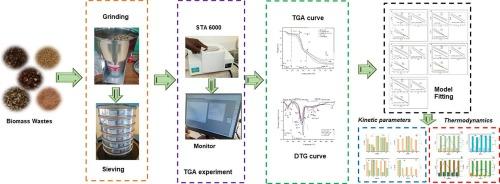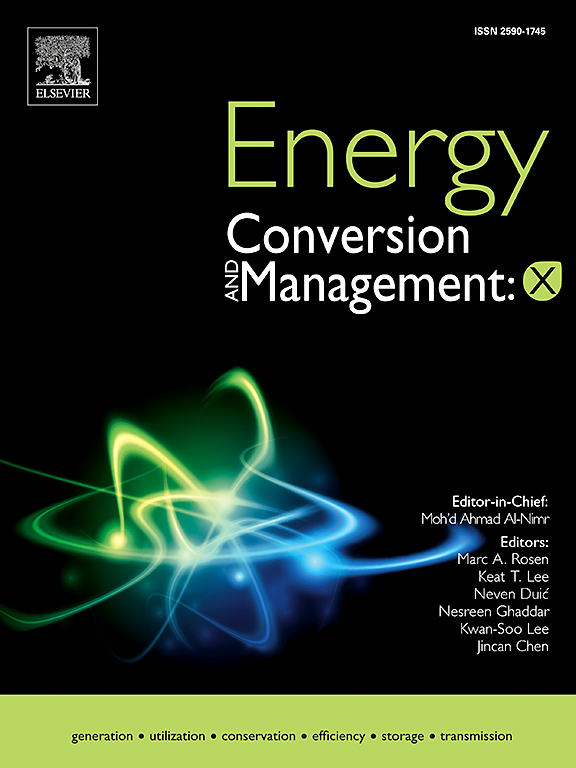通过 TGA 和 Coats-Redfern 方法对生物质废物热解进行全面的热特性、动力学和热力学分析
IF 7.1
Q1 ENERGY & FUELS
引用次数: 0
摘要
本研究采用热重分析法(TGA)和 Coats-Redfern 法全面分析了咖啡壳、花生壳、澳洲坚果壳、稻壳和茶叶废料等五种生物质废弃物的热分解特性以及动力学和热力学参数。热重分析实验是在珀金埃尔默公司的 STA 6000 仪器上进行的,实验环境为惰性气体 N2,加热速度为 20 ℃/分钟,温度范围为 25 ℃ 至 950 ℃。结果发现了三个不同的热解阶段:干燥、脱醇和成炭,其中澳洲坚果壳具有最高的热反应活性和高效的脱醇特性,这体现在其最低的初始脱醇温度(175 °C)和最高的峰值温度(380 °C)上。动力学分析表明,咖啡壳的总活化能(Ea)最高,为 60.59 kJ/mol,表明其具有复杂的热降解行为。热力学评估显示,咖啡壳的焓变最高(ΔH=55.46 kJ/mol),但吉布斯自由能变化最低(ΔG=148.34 kJ/mol),表明分解需要的能量较高,但与其他生物质相比,自发反应相对较多。澳洲坚果壳表现出较高的ΔG(163.24 kJ/mol)和适度的ΔH(32.44 kJ/mol),反映出其自发分解的阻力较大。综合热解指数(CPI)和分解指数(Ddev)证实,澳洲坚果壳是反应性最强的生物质,而稻壳的反应性最低。研究结果凸显了多步骤动力学分析对于准确理解热解过程的重要性,为优化生物质转化能源生产提供了重要的启示。未来的研究应探索不同生物质混合物的协同热解和先进的动力学建模,以提高能源产量。本文章由计算机程序翻译,如有差异,请以英文原文为准。

Comprehensive thermal properties, kinetic, and thermodynamic analyses of biomass wastes pyrolysis via TGA and Coats-Redfern methodologies
This study comprehensively analyzes the thermal decomposition characteristics as well as the kinetic and thermodynamic parameters of five biomass wastes, including coffee husk, groundnut shell, macadamia nutshell, rice husk, and tea waste, using Thermogravimetric Analysis (TGA) and the Coats-Redfern method. The TGA experiments were conducted on a PerkinElmer STA 6000 instrument under an inert N2 atmosphere with a heating rate of 20 °C/min, spanning a temperature range from 25 °C to 950 °C. The results identified three distinct pyrolysis stages: drying, devolatilization, and char formation, with macadamia nutshell demonstrating the highest thermal reactivity and efficient devolatilization characteristics, reflected by its lowest initial devolatilization temperature (175 °C) and highest peak temperature (380 °C). Kinetic analysis revealed that coffee husk had the highest overall activation energy (Ea) of 60.59 kJ/mol, indicating complex thermal degradation behavior. The thermodynamic evaluation showed that coffee husk also exhibited the highest enthalpy change (ΔH=55.46 kJ/mol) but the lowest Gibbs free energy change (ΔG=148.34 kJ/mol), suggesting high energy requirements for decomposition but relatively more spontaneous reactions compared to other biomass types. Macadamia nutshell demonstrated high ΔG (163.24 kJ/mol) and moderate ΔH (32.44 kJ/mol), reflecting greater resistance to spontaneous decomposition. The comprehensive pyrolysis index (CPI) and devolatilization index (Ddev) confirmed macadamia nutshell as the most reactive biomass, while rice husk exhibited the lowest reactivity. The findings highlight the importance of multi-step kinetic analysis for accurately understanding pyrolysis processes, providing critical insights for optimizing biomass conversion for energy production. Future research should explore co-pyrolysis with varied biomass mixtures and advanced kinetic modeling to enhance energy yields.
求助全文
通过发布文献求助,成功后即可免费获取论文全文。
去求助
来源期刊

Energy Conversion and Management-X
Multiple-
CiteScore
8.80
自引率
3.20%
发文量
180
审稿时长
58 days
期刊介绍:
Energy Conversion and Management: X is the open access extension of the reputable journal Energy Conversion and Management, serving as a platform for interdisciplinary research on a wide array of critical energy subjects. The journal is dedicated to publishing original contributions and in-depth technical review articles that present groundbreaking research on topics spanning energy generation, utilization, conversion, storage, transmission, conservation, management, and sustainability.
The scope of Energy Conversion and Management: X encompasses various forms of energy, including mechanical, thermal, nuclear, chemical, electromagnetic, magnetic, and electric energy. It addresses all known energy resources, highlighting both conventional sources like fossil fuels and nuclear power, as well as renewable resources such as solar, biomass, hydro, wind, geothermal, and ocean energy.
 求助内容:
求助内容: 应助结果提醒方式:
应助结果提醒方式:


